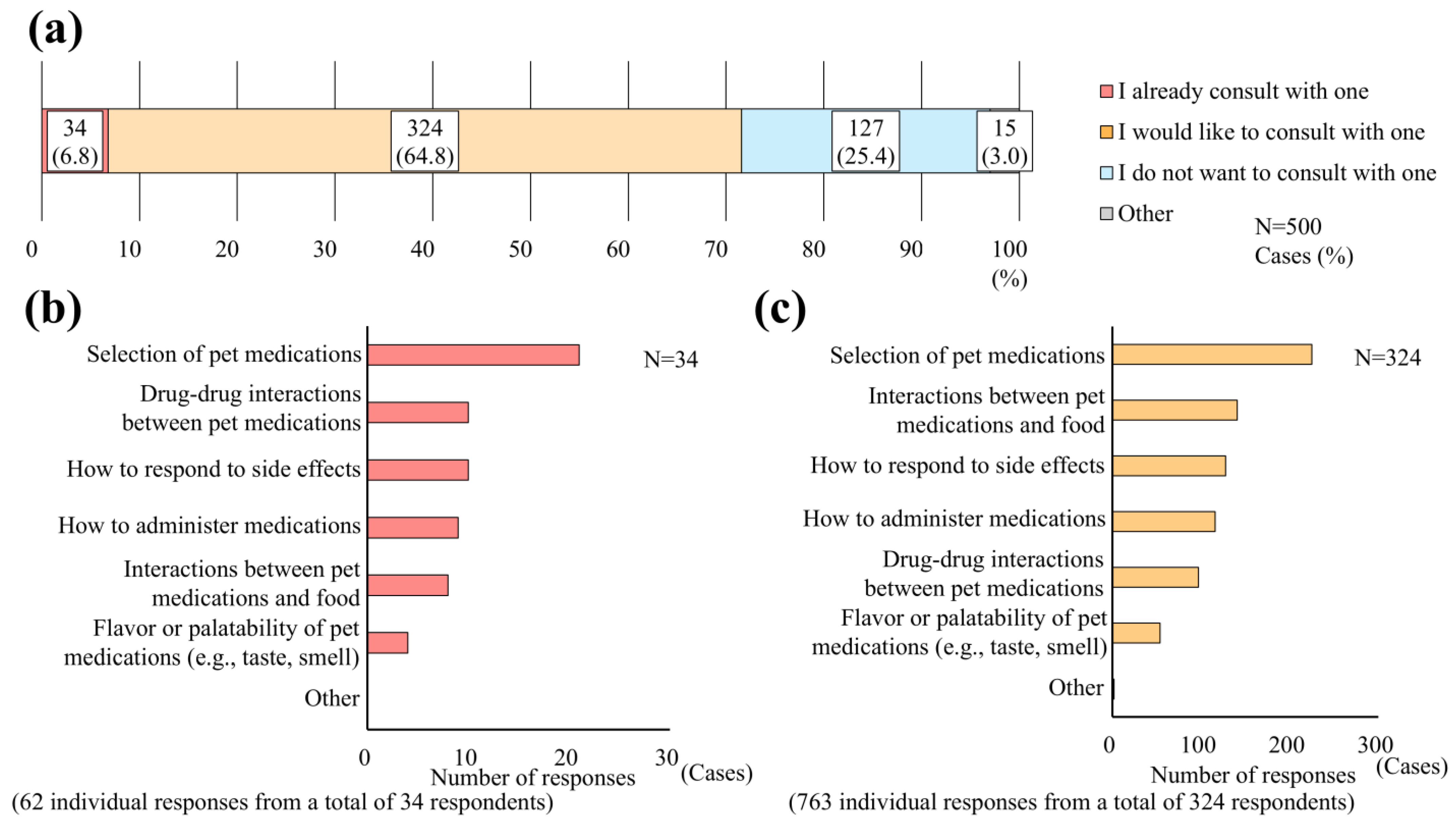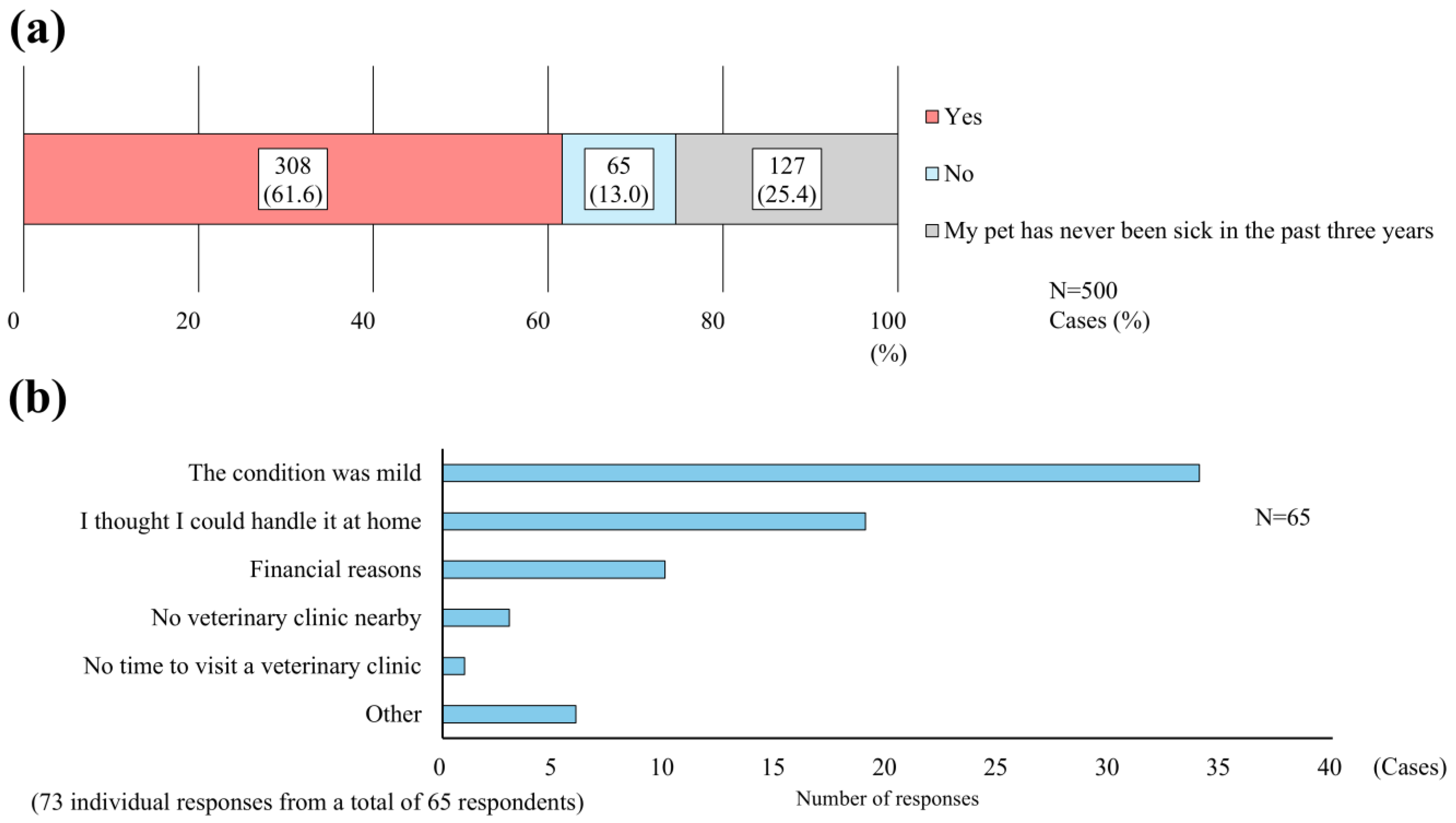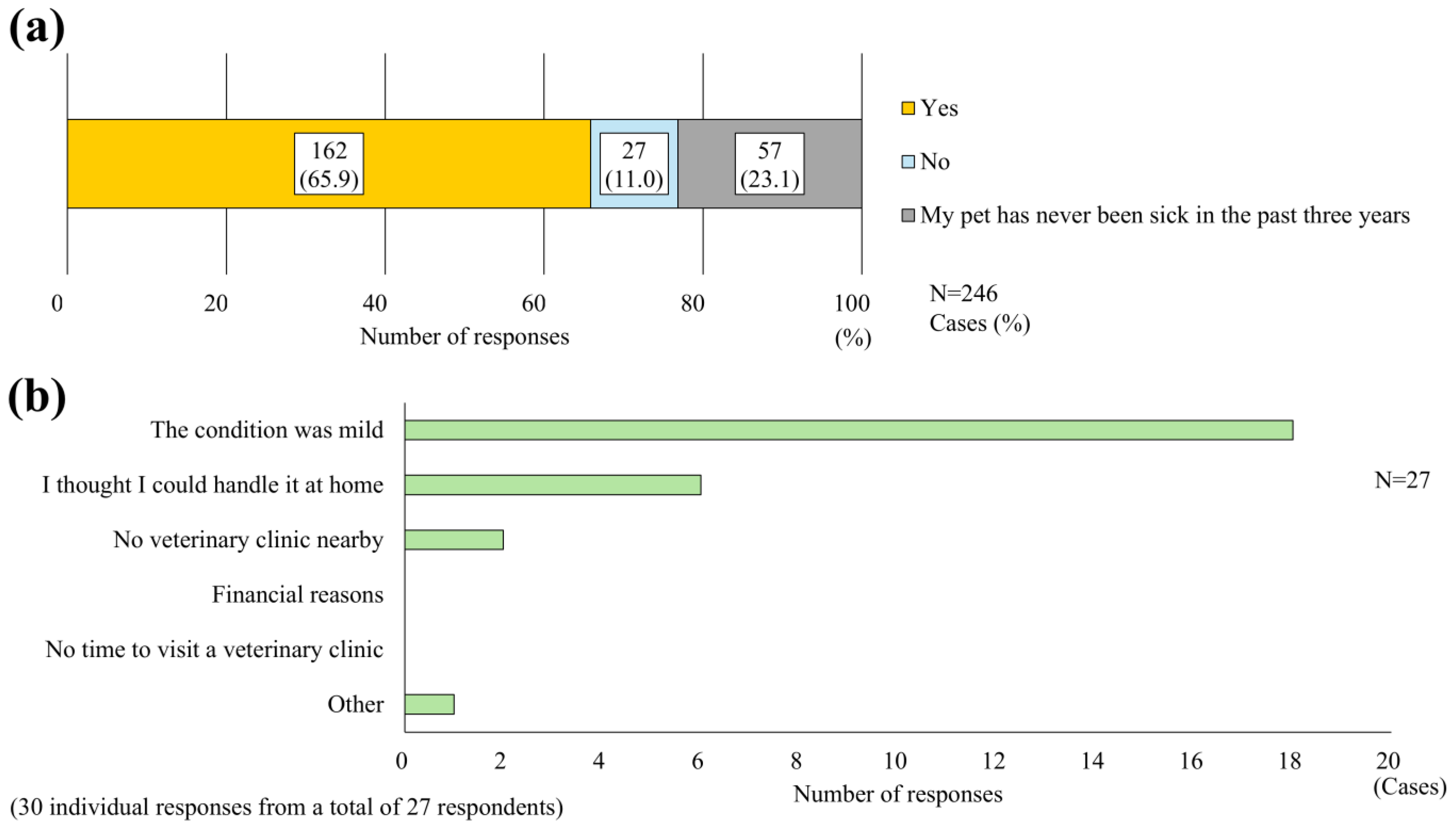Self-Medication Practices for Companion Animals in Japan: A Descriptive Survey of Pet Owners’ Use of Over-the-Counter Drugs and Perspectives on Pharmaceutical Care
Abstract
1. Introduction
2. Materials and Methods
2.1. Survey Design
2.2. Questionnaire Structure
2.3. Study Participants and Data Collection
3. Results
3.1. Demographic Characteristics of Pet Owners
3.2. Willingness to Consult Pharmacists About Pet Medications
3.3. Veterinary Visit Behavior and Reasons for Non-Visit
3.4. Use and Purchasing Behavior of OTC Medications for Pets
3.5. Monthly Expenditure on OTC Pet Medications
4. Discussion
5. Conclusions
Supplementary Materials
Author Contributions
Funding
Institutional Review Board Statement
Informed Consent Statement
Data Availability Statement
Acknowledgments
Conflicts of Interest
References
- Sueda, K.L.C.; Hart, B.L.; Cliff, K.D. Characterisation of plant eating in dogs. Appl. Anim. Behav. Sci. 2008, 111, 120–132. [Google Scholar] [CrossRef]
- Pons-Hernandez, M.; Wyatt, T.; Hall, A. Investigating the illicit market in veterinary medicines: An exploratory online study with pet owners in the United Kingdom. Trends Organ. Crim. 2023, 26, 308–328. [Google Scholar] [CrossRef] [PubMed]
- Nichelason, A.E.; Williams, S.R.; Pinto, A.; Bean, I. Convenience and price drive online pharmacy usage by veterinary clients. J. Am. Vet. Med. Assoc. 2024, 262, 1511–1517. [Google Scholar] [CrossRef] [PubMed]
- Fredrickson, M.E.; Terlizzi, H.; Horne, R.L.; Dannemiller, S. The role of the community pharmacist in veterinary patient care: A cross-sectional study of pharmacist and veterinarian viewpoints. Pharm. Pract. 2020, 18, 1928. [Google Scholar] [CrossRef] [PubMed]
- Taylor, D.D.; Scallan Walter, E.J. Colorado pet owners’ perceptions of and attitudes towards antimicrobial drug use and resistance. Vet. Rec. 2023, 192, e2583. [Google Scholar] [CrossRef] [PubMed]
- McDaniel, M.; Glazier, E.; Truong, N.; Marsh, L.; Cahill, N.; Essel, L.B.; Melton, B.L.; Meyer, E.G. Veterinary prescription errors in a community pharmacy setting: A retrospective review. J. Am. Pharm. Assoc. 2022, 62, 512–518. [Google Scholar] [CrossRef] [PubMed]
- Konno, T.; Suzuki, H.; Suzuki, N.; Okada, K.; Nishikawa, Y.; Kikuchi, D.; Nakamura, H.; Murai, Y. Current situation for pharmacists in Japanese veterinary medicine: Exploring the pharmaceutical needs and challenges of veterinary staff to facilitate collaborative veterinary care. Pharmacy 2024, 12, 179. [Google Scholar] [CrossRef] [PubMed]
- Konno, T.; Suzuki, H.; Kikuchi, D.; Nishikawa, Y.; Kisara, S.; Nakamura, H.; Murai, Y. Future perspectives on household pharmaceutical management and medication administration for companion animals in Japan. Pharm. Pract. 2025; In press. [Google Scholar]
- Pharmacy Co., Ltd. 12 Pharmacy: Dispensing-Separation Model Dedicated to Animal Hospitals. Available online: https://12pharmacy.co.jp/ (accessed on 1 September 2025). (In Japanese).
- Cygni Inc. Cygni: E-Commerce Platform for Veterinary Clinics. Available online: https://vet.cygni.co.jp/disp/CPWIncludeWide_vet.jsp?dispNo=006102001001 (accessed on 1 September 2025). (In Japanese).
- Pet-Yaku. Pet-Yaku: Online Information and Supply for Pet Medicines. Available online: https://www.pet-yaku.com/ (accessed on 1 September 2025). (In Japanese).
- Ministry of Health, Labour and Welfare. Annual Report of Public Health Administration and Services (FY2023), Results Summary—4. Pharmaceutical Affairs. 2024. Available online: https://www.mhlw.go.jp/toukei/saikin/hw/eisei_houkoku/23/dl/kekka4.pdf (accessed on 1 September 2025). (In Japanese).
- Japan Pet Food Association (JPFA). National Dog and Cat Ownership Survey: Key Indicators Summary 2024. Available online: https://petfood.or.jp/pdf/data/2024/3.pdf (accessed on 1 November 2025). (In Japanese).
- Kovačević, Z.; Mijač, J.; Ružić-Muslić, D.; Ćupić, T. Exploring pet owners’ attitudes toward compounded and human-approved medicines: A questionnaire-based pilot study. Vet. Res. Commun. 2025, 49, 64. [Google Scholar] [CrossRef] [PubMed]
- Davidson, G. Veterinary Compounding: Regulation, Challenges, and Resources. Pharmaceutics 2017, 9, 5. [Google Scholar] [CrossRef] [PubMed]
- Tokyo University of Pharmacy and Life Sciences. Initiative To Develop an Educational Program for Pharmacists Engaged in Veterinary Medicine. 2025. Available online: https://www.toyaku.ac.jp/pharmacy/newstopics/2025/0626_6783.html (accessed on 1 September 2025). (In Japanese).
- Rand, J.; Morton, J.M.; Dias, R. Situational analysis of cat ownership and cat caring: Exploring the diversity of cat management practices and their welfare implications. Animals 2024, 14, 2849. [Google Scholar] [CrossRef]
- Destoumieux-Garzón, D.; Mavingui, P.; Boetsch, G.; Boissier, J.; Darriet, F.; Duboz, P.; Fritsch, C.; Giraudoux, P.; Le Roux, F.; Morand, S.; et al. The one health concept: 10 years old and a long road ahead. Front. Vet. Sci. 2018, 5, 14. [Google Scholar] [CrossRef] [PubMed]









| Characteristic | N (%) | Total | |
|---|---|---|---|
| The type of pet you keep | Dogs | 246 (49.2) | 500 |
| Cats | 210 (42.0) | ||
| Both | 44 (8.8) | ||
| Owner’s age (Years) | 18–19 | 1 (0.2) | 500 |
| 20–39 | 67 (13.4) | ||
| 40–59 | 247 (49.4) | ||
| 60–79 | 184 (36.8) | ||
| ≥80 | 1 (0.2) | ||
| Characteristic | N (%) | Total | |
|---|---|---|---|
| Monthly expenditure on OTC pet medications | <3000 yen | 34 (44.7) | 76 |
| 3000 to <5000 yen | 25 (32.9) | ||
| 5000 to <10,000 yen | 13 (17.1) | ||
| 10,000 to <30,000 yen | 4 (5.3) | ||
| 30,000 to <50,000 yen | 0 (0.0) | ||
| ≥50,000 yen | 0 (0.0) | ||
| Characteristic | N (%) | Total | |
|---|---|---|---|
| Monthly expenditure on OTC pet medications | <3000 yen | 19 (43.2) | 44 |
| 3000 to <5000 yen | 13 (29.5) | ||
| 5000 to <10,000 yen | 8 (18.2) | ||
| 10,000 to <30,000 yen | 4 (9.1) | ||
| 30,000 to <50,000 yen | 0 (0.0) | ||
| ≥50,000 yen | 0 (0.0) | ||
| Characteristic | N (%) | Total | |
|---|---|---|---|
| Monthly expenditure on OTC pet medications | <3000 yen | 13 (56.5) | 23 |
| 3000 to <5000 yen | 8 (34.8) | ||
| 5000 to <10,000 yen | 2 (8.7) | ||
| 10,000 to <30,000 yen | 0 (0.0) | ||
| 30,000 to <50,000 yen | 0 (0.0) | ||
| ≥50,000 yen | 0 (0.0) | ||
Disclaimer/Publisher’s Note: The statements, opinions and data contained in all publications are solely those of the individual author(s) and contributor(s) and not of MDPI and/or the editor(s). MDPI and/or the editor(s) disclaim responsibility for any injury to people or property resulting from any ideas, methods, instructions or products referred to in the content. |
© 2025 by the authors. Licensee MDPI, Basel, Switzerland. This article is an open access article distributed under the terms and conditions of the Creative Commons Attribution (CC BY) license (https://creativecommons.org/licenses/by/4.0/).
Share and Cite
Konno, T.; Kikuchi, D.; Suzuki, H.; Nishikawa, Y.; Kisara, S.; Nakamura, H.; Murai, Y. Self-Medication Practices for Companion Animals in Japan: A Descriptive Survey of Pet Owners’ Use of Over-the-Counter Drugs and Perspectives on Pharmaceutical Care. Pets 2025, 2, 39. https://doi.org/10.3390/pets2040039
Konno T, Kikuchi D, Suzuki H, Nishikawa Y, Kisara S, Nakamura H, Murai Y. Self-Medication Practices for Companion Animals in Japan: A Descriptive Survey of Pet Owners’ Use of Over-the-Counter Drugs and Perspectives on Pharmaceutical Care. Pets. 2025; 2(4):39. https://doi.org/10.3390/pets2040039
Chicago/Turabian StyleKonno, Taisuke, Daisuke Kikuchi, Hiroyuki Suzuki, Yosuke Nishikawa, Shigeki Kisara, Hitoshi Nakamura, and Yuriko Murai. 2025. "Self-Medication Practices for Companion Animals in Japan: A Descriptive Survey of Pet Owners’ Use of Over-the-Counter Drugs and Perspectives on Pharmaceutical Care" Pets 2, no. 4: 39. https://doi.org/10.3390/pets2040039
APA StyleKonno, T., Kikuchi, D., Suzuki, H., Nishikawa, Y., Kisara, S., Nakamura, H., & Murai, Y. (2025). Self-Medication Practices for Companion Animals in Japan: A Descriptive Survey of Pet Owners’ Use of Over-the-Counter Drugs and Perspectives on Pharmaceutical Care. Pets, 2(4), 39. https://doi.org/10.3390/pets2040039






